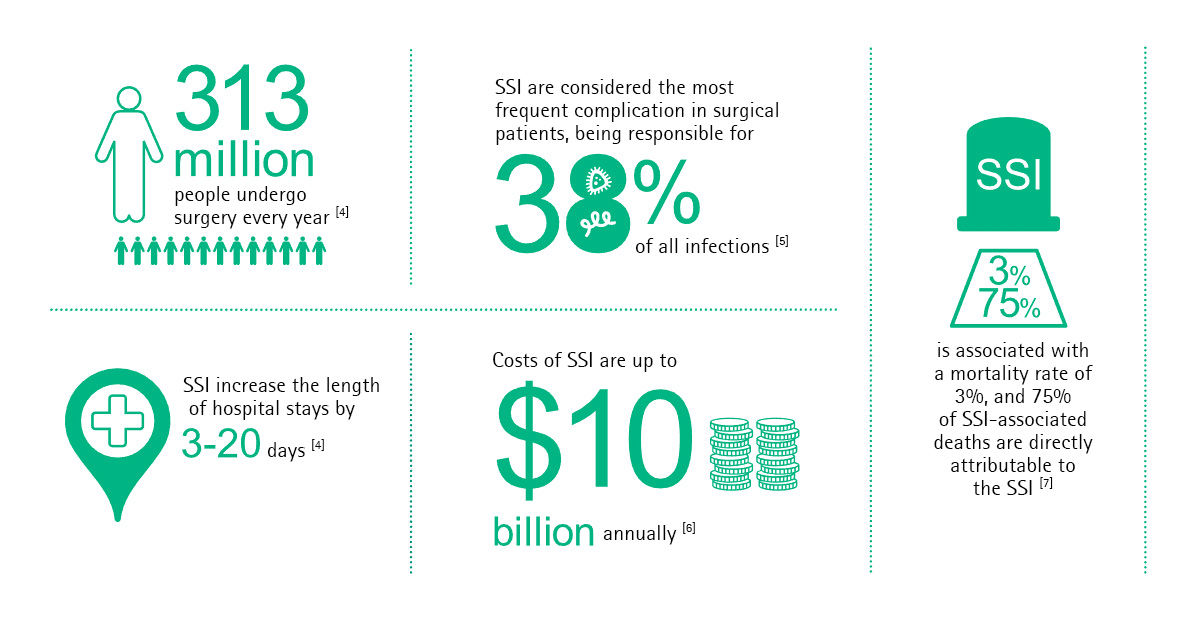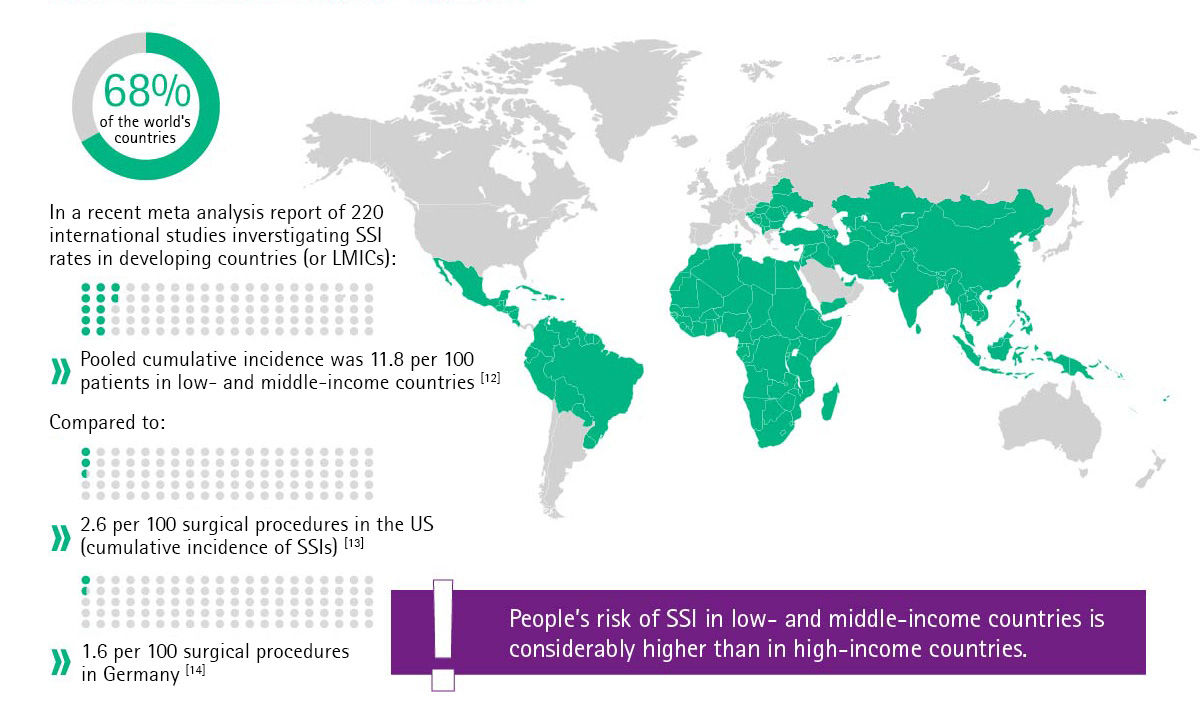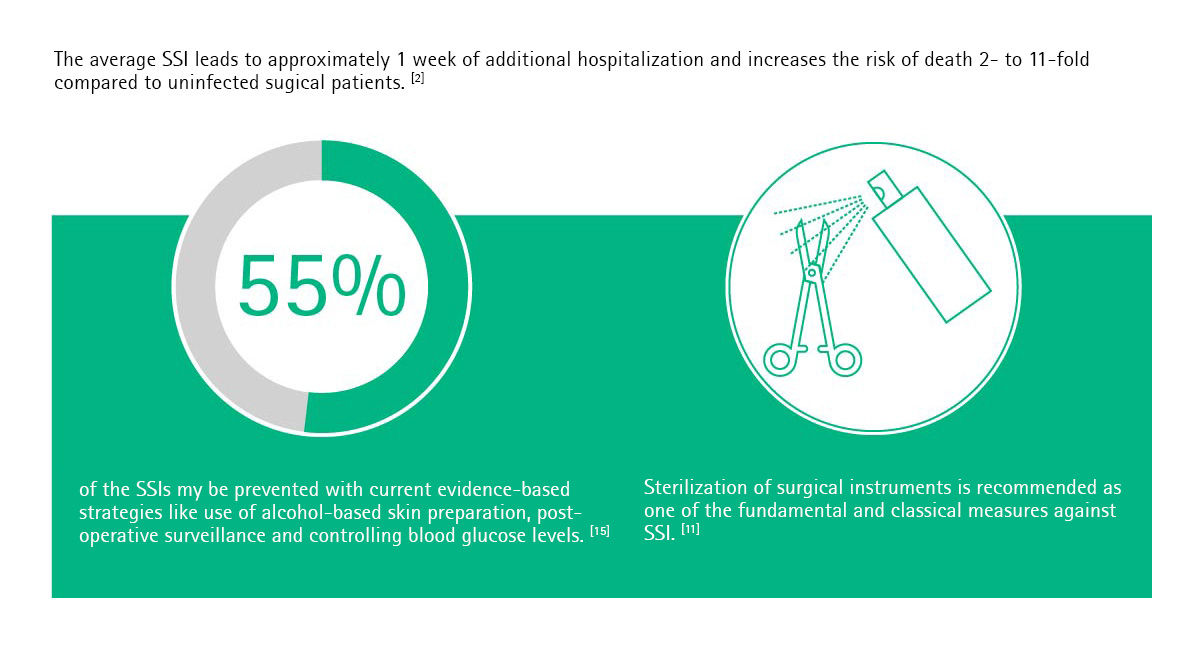You have successfully logged out.
Not registered yet?
Infection Prevention CSSD
The global problem of post-operative infections
Surgical site infection (SSI) is the most frequent type of health care-associated infection (HAI) in low- and middle-income countries, LMICs, [1] (68% of the world‘s countries [2]). According to WHO reports, approximately 1 in 10 people who have surgery in LMICs acquire SSIs. In addition to the risk and discomfort for the patient, SSIs dramatically increase the direct and indirect cost of treatment and reduce health-related quality of life. [3]
Medical Professional
This information is meant for medical professionals only. Please confirm that you are a medical professional before accessing the information.
Confirm Yes, I am a health care professional. Cancel No, I am not a health care professional.
SSI incidence in Latin America – Example Mexico
-
SSI rates
0%
higher!
Surgical instruments pose risk of contamination
Surgical instruments could act as fomites for the pathogens of surgical site infection even if the surgical field is not evidently contaminated. [11]
Low- and middle-income countries

Prevention of surgical site infections starts with instrument reprocessing
More information about how you can optimize your CSSD/SPD workflow processes via digitalization and the first voices of users by downloading this whitepaper.
Register now to access white paper downloadThe avoidance of SSIs protects patients from serious complications

Economic consequences of surgical site infections (SSI)
Health care-associated infections (HAIs), especially surgical site infections (SSIs) ...
Read moreCentral Sterile Supply Department: Patient safety starts here
The CSSD plays a vital role in patient safety and in reducing hospital surgical infection ...
Read more[1] WHO Protocol for surgical site infection surveillance with a focus on settings with limited resources, 2018.
[2] Rosenthal VD, Richtmann R, Singh S, Apisarnthanarak A, Kübler A, Viet-Hung N et al. Surgical Site Infections, International Nosocomial Infection Control Consortium Report, Data Summary of 30 Countries, 2005–2010. Infect Control Hosp Epidemiol. 2013 Jun;34(6):597-604.
[3] Umscheid CA, Mitchell MD, Doshi JA, Agarwal R, Williams K, Brennan PJ. Infect Control Hosp Epidemiol. Estimating the proportion of healthcare-associated infections that are reasonably preventable and the related mortality and costs. 2011 Feb;32(2):101-14. doi:10.1086/657912.
[4] World Health Organization, 2016. Hand hygiene and the surgical patient journey. [Online] Available at: 1 [Accessed 23 January 2024].
[5] Wiseman JT, Fernandez-Taylor S, Barnes M, et al. Predictors of surgical site infection after hospital discharge in patients undergoing major vascular surgery. J Vasc Surg. 2015;62(4):1023-31.
[6] Title : Centers for Disease Control and Prevention Guideline for the Prevention of Surgical Site Infection, 2017, Published Date : August 1, 2017 Centers for Disease Control and Prevention Guideline for the Prevention of Surgical Site Infection, 2017 (cdc.gov) accessed 23.01.2024.
[7] Centers for Disease Control and Prevention. (CDC). 9 Surgical Site Infection (SSI) Event (apic.org) (accessed 23.01.2024).
[8] Portillo-Gallo JH, Miranda-Novales MG, Rosenthal VD, Sánchez M, Ayala-Gaytan JJ, Ortiz-Juárez VR et al. Surgical site infection rates in four Mexican cities: Findings of the International Nosocomial Infection Control Consortium (INICC). J Infect Public Health. 2014 Nov-Dec;7(6):465-71.
[9] Charry L, Andrade PC, Cabra H. Systematic Review of Clinical and Economic Outcomes Related to Surgical Site Infections in Latin America. Value in Health 2016 Nov;19(3), A223.
[10] WHO Health care-associated infections FACT SHEET 9789241501507_eng.pdf (who.int) accessed 23.01.2024.
[11] Saito Y, Kobayashi H, Uetera Y, Yasuhara H, Kajiura T, Okubo T. Microbial contamination of surgical instruments used for laparotomy. American Journal of Infection Control, Volume 42, Issue 1, 43-47.
[12] Allegranzi B Bagheri Nejad S, Combescure C, Graafmans W, Attar H, Donaldson L et al. Burden of endemic health-care-associated infection in developing countries: systematic review and meta analysis. Lancet. 2011 Jan 15;377(9761):228-41.
[13] Gaynes RP, Culver DH, Horan TC, Edwards JR, Richards C, et al. (2001) Surgical site infection (SSI) rates in the United States, 1992–1998: the National Nosocomial Infections Surveillance System basic SSI risk index. Clin Infect Dis 33: 69-77.
[14] Gastmeier P, Geffers C, Brandt C, Zuschneid I, Sohr D, et al. (2006) Effectiveness of a nationwide nosocomial infection surveillance system for reducing nosocomial infections. J Hosp Infect 64: 16-22.
[15] Conway LJ1, Pogorzelska M, Larson EL, Stone PW. Surgical Site Infection Prevention Policies and Adherence in California Hospitals, 2010. Infect Control Hosp Epidemiol. 2012 Jun; 33(6): 640-1.